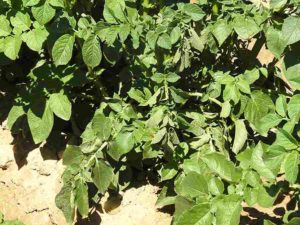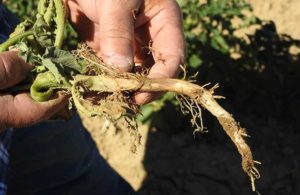Dickeya: A New Potato Disease

These potato plants are showing early symptoms of Dickeya. Photo credit: Margaret McGrath
Known as Dickeya blackleg because symptoms are similar to blackleg, or just Dickeya, this disease is causing trouble for potato growers in the Northeast and particularly seed producers in Maine. An aggressive pathogen, the bacterium Dickeya dianthicola thrives in hot temperatures, which many areas in the Northeast are currently experiencing.
Margaret Tuttle McGrath, a plant pathologist at Cornell University, says the greatest losses last year occurred in the Mid-Atlantic region and farther south.
She adds that some growers lost entire fields in 2015. The disease has been documented in potato fields this year, too.
What To Look For
The symptoms growers need to be wary of begin with poor emergence resulting in scattered blank spots in the fields. Contaminated plants that are able to emerge typically wilt and have black stems.
“Because the bacterium thrives in heat, as the temperature increases, we will see more plants dropping out,” she adds.
Wetness may also be an issue as rainwater may help move the pathogen adjacent plants. She adds, however, that any movement wouldn’t be far.

This stem shows initial symptoms of Dickeya, a new potato disease. Photo credit: Margaret McGrath
The problem, McGrath says, is the Dickeya pathogen is in the seed, making management in a production field difficult.
Unfortunately, McGrath says fungicides cannot fight this bacterium and there are no resistant varieties available. One thing researchers do know is the bacterium isn’t known to live in the soil for long periods.
“From what we know, it doesn’t survive in the soil for long enough to be an issue for the next potato crop in a field, except in unharvested infested tubers,” she explains. “This is good news for growers but it puts more of the onus for management on the seed producer.”
Monitor Field Conditions
McGrath encourages growers to monitor what is happening in their potato fields and pay attention to which varieties are affected.
Using potato seed that is free of Dickeya is the best management practice, she says. The problem with this practice, however, is symptoms often don’t develop in cool temperatures, which are typical in seed-producing areas.
Is there a test available to determine the presence of Dickeya on seed? McGrath says not yet, and infected seed can appear healthy, further complicating the issue.
What about Disease Tolerance?
In addition, she says an agreement has not been reached regarding tolerance for the pathogen in seed.
“There are differing opinions about whether there should be no tolerance for Dickeya, similar to bacterial ring rot, in certified potato seed, or whether a low percentage of contaminated seed can be tolerated as is the case with other diseases such as late blight,” McGrath says. “A major difference is that there are resistant varieties and effective fungicides for managing late blight.”
Stay tuned to GrowingProduce.com for additional details on Dickeya.










